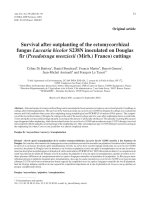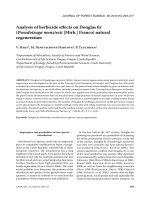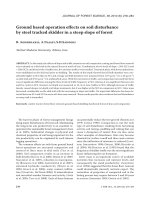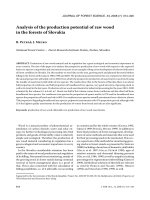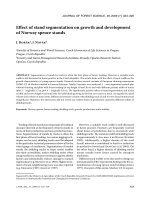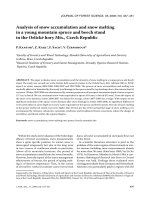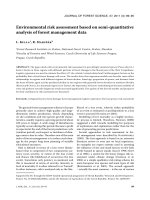Báo cáo lâm nghiệp: "Analysis of herbicide effects on Douglas fir (Pseudotsuga menziesii [Mirb.] Franco) natural regeneration" ppsx
Bạn đang xem bản rút gọn của tài liệu. Xem và tải ngay bản đầy đủ của tài liệu tại đây (218.66 KB, 9 trang )
J. FOR. SCI., 56, 2010 (5): 209–217 209
JOURNAL OF FOREST SCIENCE, 56, 2010 (5): 209–217
Importance and possibilities of tree species
introduction
Introduced tree species could take an important
place in sustainable multifunction forest manage-
ment in the Czech Republic, similarly like in other
European countries. e introduction has a long
tradition in the Czech lands. Tree species have been
introduced not only for aesthetic purposes but also
for their wood and non-wood-producing functions.
Further, thanks to their high potential, they are
hardly replaceable (H, R 2006). e most
actual problem is to determine the position of the
introduced tree species in the present forest man-
agement, it means to confirm or to overcome the
assumption of their importance and utilization.
In the first half of the 20
th
century, Douglas fir
growing was perceived as a possibility of increasing
the forest productivity. On the contrary, at the end
of the century, Douglas fir (Pseudotsuga menziesii)
was seen very critically and near-natural forestry
was preferred (M, K 2004). The
actual experiences confirm that Douglas fir is one
of the most productive tree species. is statement
was mentioned by authors from the Czech Republic
(H 1964; W 1998a,b; K et al. 2001;
R
2002; K, K 2006; K
2008) as well as from the neighbouring countries
(H 1996; B, G 1996; G
1996; P et al. 2001). Mainly data on high
growing stock, wood production and especially the
values of mensurational indices attract attention. At
Analysis of herbicide effects on Douglas fir
(Pseudotsuga menziesii [Mirb.] Franco) natural
regeneration
V. H
1
, M. N-H
2
, P. T
1
1
Department of Silviculture, Faculty of Forestry and Wood Sciences,
Czech University of Life Sciences Prague, Prague, Czech Republic
2
Department of Ecology, Faculty of Environmental Sciences, Czech University
of Life Sciences Prague, Prague, Czech Republic
ABSTRACT: Douglas fir (Pseudotsuga menziesii [Mirb.] Franco) natural regeneration under parent stand after weed
suppression was investigated in the area of the Training Forest Enterprise in Kostelec nad Černými lesy. e study
evaluates two measurements made in a two-year interval. e parent stand, where Douglas fir grows in mixture with
our domestic tree species, is one of the oldest and most productive stands at the Training Forest Enterprise in Kostelec
nad Černými lesy. Herbicides for the control of weeds were applied onto three permanent experimental plots under
the parent stand. Measurements done on the plots show a high potential of natural regeneration in areas where the
negative impact of forest weeds was suppressed. is conclusion is acknowledged by the high seedling number found
on research plots treated with herbicides. e number of Douglas fir seedlings varied from 21,600 per hectare counted
on the plot treated with Dominator to 26,650 seedlings on the plot with Velpar treatment even six years after the soil
preparation. Statistical analysis confirmed that the seedling number on the plot without any chemical preparation was
significantly lower, only 950 individuals per hectare (χ
2
= 926.84, df = 3, P << 0.01).
Keywords: Douglas fir; herbicides; introduced tree species; natural regeneration
210 J. FOR. SCI., 56, 2010 (5): 209–217
present, Douglas fir grows in our forests on the area
of 4,808.5 ha, that is about 0.2% of forest land of the
Czech Republic. Forest stands of the first four age
classes prevail (A 2008). Further, a favour-
able impact of this species on forest soil is expected
(P 1998; P, R 2006, 2008;
P et al. 2009).
Introduction in the area of the Training Forest
Enterprise in Kostelec nad Černými lesy has a long
tradition and is mainly connected with Liechtenstein
estate. On the area of 6,734 ha, Douglas fir occurs in
98 stands and its proportion ranges from 5 to 100%.
Douglas fir reduced area is 14.56 ha, i.e. 0.22% of the
overall stand area at the Training Forest Enterprise.
e provenance suitability for the import of high-
quality seed has been discussed very often. Accord-
ing to Č (2001) the superior sources of
the necessary amount of seed of an acceptable and
well-tried provenance are sufficient. Hence, mainly
domestic seed sources should be used and we should
also take advantage of natural regeneration. Accord-
ing to a study worked up by the Forestry and Game
Management Research Institute in Jíloviště-Strnady,
Douglas fir could be regenerated and planted on up
to 2% of the yearly regenerated area, i.e. on 400 to 500
ha (Š 2003).
Natural regeneration
Natural regeneration is a native process taking place
in forest development. It is the ability and product
of the forest ecosystem self-reproduction. Never-
theless, we can consider natural regeneration to be
a result of the purposeful and systematic work of a
forest manager (K et al. 1991). B (2007a)
stated that natural regeneration of forest tree species
is known to be one of the fundamental and regular
processes of the life cycle of each virgin forest and
native forest. Natural regeneration is particularly
important for the preservation of genetic resources
of forest tree species populations. Further, the risk of
the temporal or permanent deterioration of forest site
conditions is much lower in comparison with artificial
regeneration. Natural regeneration enables to grow
high-quality stands because the number of naturally
regenerated individuals is much higher than that of
artificially planted ones and thus we have much more
possibilities to choose superior individuals during
stand tending. Natural regeneration is a notable part
of near-natural forest management (K 2002). It
also contributes to a higher stability of forest ecosys-
tems (P 1997; P 1998).
Biological conditions for Douglas fir natural regen-
eration are favourable at most sites. e interval be-
tween seed years is 5–7 years, the beginning of fertility
is at the age of 20 to 30 and it lasts till high age. Seeds
germinate well in mineral soil. Most seeds fall to a
distance of 300 m from the stand of generative Doug-
las fir trees (Ú, C 1995). H
(1964) stated that Douglas fir natural regeneration
under the shelter of parent stand takes place quite fre-
quently in most European countries. It appears mainly
in properly tended stands at the age of 60 years. Prob-
lems with pollination may arise if Douglas fir occurs
in small groups or is only interspersed. Further, a huge
amount of dead seeds is present (K, Š 1987).
Very little is known about parthenocarpy.
Š (2003) and Š and B (2004)
reported that it is possible and convenient to regen-
erate high-quality Douglas fir stands in a natural
way at favourable sites in conditions of the Czech
Republic. For the success of natural regeneration they
recommended to prepare hospitable conditions by
formation of the crown canopy and by soil prepara-
tion during the seed year. According to K et al.
(1991) light is the most important factor after sprout-
ing of seedlings. B (2007b) concluded that the
lateral light is much more important for the natural
regeneration density than the light coming through
the parent stand crowns. e study by K and
Š (1987) confirmed that Douglas fir regenerated
very well (abundance 400–5,000 individuals
.
ha
–1
)
mainly thanks to the lateral self-seeding, in conditions
of the 3K forest type group. Coherent regeneration
appeared even in places from which the nearest Doug-
las fir trees were 25 m distant. W (1998a,b), who
conducted his research work in the surroundings of
the town of Písek, found out that Douglas fir natural
regeneration is possible on acid soil with less aggres-
sive weeds. Conversely, most seedlings died mainly
during the second and third year as a consequence
of weed competition on more nutrient-rich soils.
H and R (2006) presented their very good
experiences with natural regeneration under parent
stand at the Training Forest Enterprise in Kostelec
nad Černými lesy after the application of herbicides
that suppressed the negative influence of weeds on
seedlings. e present study is the continuation and
enlargement of such research. e aim of the study is
to confirm the utility and relevance of chemical soil
preparation in forest management.
MATERIAL AND METHODS
Study area
e area of the Training Forest Enterprise in Kos-
telec nad Černými lesy is located 25–50 km north-
J. FOR. SCI., 56, 2010 (5): 209–217 211
east of Prague. e altitude ranges from 210–538 m
a.s.l. Climatic characteristics include the mean an-
nual temperature 7.0–7.5°C and 13.0–13.8°C during
the growing season. Growing season lasts 153 days
on average. e mean annual precipitation amounts
to 600–650 mm. Rainfall distribution during the year
is favourable (65% of rainfall during the growing sea-
son). e wind direction is modified by the terrain to
a great extent. West winds prevail, destructive winds
from the southeast blow scarcely (Forest Manage-
ment Plan 2001).
Forest stand 441D10 is situated in the Jevany for-
est district, 4 km southeast of Kostelec nad Černými
lesy. It is located on a moderate northeastern slope.
e main forest type is 4O1, management set of
stands is 461. e stand size is 3.29 ha. e tree spe-
cies composition is as follows: Norway spruce (Picea
abies [L.] Karst.) 75%, Douglas fir (Pseudotsuga men-
ziesii [Mirb.] Franco) 25%, other tree species silver
fir (Abies alba Mill.), Scots pine (Pinus sylvestris
[L.]), European larch (Larix decidua Mill.), sessile
oak (Quercus petraea [Matt.] Liebl.) and European
birch (Betula verrucosa Ehrh.) are interspersed.
Douglas fir and Norway spruce fructify every year.
e altitude of the stand is 410 m a.s.l. Stocking was
10 and the canopy was open at the time of the trial
establishment. e age of the stand is 100 years, the
canopy is open and stocking was 11 in 2008.
ree permanent research plots (PRP) were estab-
lished under the parent stand. PRP are 0.04 ha square-
shaped areas located 30 m from the forest edge. Each
PRP is divided into 400 squares with 1 m long sides.
e canopy is 79% on PRP 1.73% on PRP 2 and 64%
on PRP 3. e seedling number was monitored in
each square in 2006 and 2008. Survival of seedlings
was figured out thanks to repeated seedling numera-
tion and consequent determination of age. Seedling
height and diameter at root collar were also monitored.
e evaluation of these parameters will be the aim of
another study.
Weed control
Three types of herbicides were applied onto
PRPs (Table 1 shows the types, concentrations and
amounts of the chemicals). Herbicides were used
to minimize the weed competition and to enable
natural regeneration. Before the soil preparation
was done, several Norway spruce trees were felled
to open the canopy and to increase the amount of
incident light necessary for seedling growth. e
herbicide application was realized in 2002. ere
were no weeds on all PRPs after the application of
herbicides and the site conditions were also the same
and thus we can consider that the initial conditions
for seedling establishment were identical on all PRPs.
e effects of herbicides on seedling growth could
then be easily observed.
e investigation began four years after the appli-
cation of herbicides to avoid the effects of residues
of the herbicide active substances on seedlings. Two
measurements carried out in a two-year interval
(2006 and 2008) always after the end of growing
season are mentioned in the present study. In 2008,
one check measurement was done on a plot without
soil preparation to find out the impact of herbicide
application on natural regeneration. e number and
species of seedlings were determined and also their
age and height (their evaluation will be the subject
of a further study).
Statistical analysis
e differences between PRPs were examined us-
ing the χ
2
test according to Z (2006):
r c
(N
ij
– n
i
× N
j
/n)
2
χ
2
=
∑ ∑
–––––––––––––––
i = 1 j =1
n
i
× N
j
/n
where:
N
ij
– observed seedling frequencies,
n
i
×
N
j
/n – expected seedling frequencies,
r (c) – number of research plots (tree species).
e analyses were done for each year separately.
If the calculated value exceeded the critical χ
2
value,
the differences were considered as statistically sig-
nificant (the degrees of freedom df used in the sta-
tistical evaluation are either 2 or 3 for a comparison
of Douglas fir numbers between the particular plots,
Table 1. Chemical preparatives and concentration
Permanent research plot
Application date Herbicide Herbicide amount
1 2. 5. 2002 Velpar 90 3 kg/400 l water
2 2. 5. 2002 Roundup Forte 3.5 kg/200 l water
3 2. 5. 2002 Dominator 7 l /200 l water
212 J. FOR. SCI., 56, 2010 (5): 209–217
the critical value is 5.9918 or 7.8153 for a 0.05 sig-
nificance level; or 4 when comparing two PRPs, the
critical value is 9.4884 for a 0.05 significance level;
or 8 when comparing three PRPs, the critical value
is 15.509 for a 0.05 significance level; or the df are 12
when comparing three PRPs and the check plot, the
critical value is 21.028 for a 0.05 significance level).
RESULTS AND DISCUSSION
e chemical soil preparation that was applied onto
PRPs and was to help the natural regeneration sur-
vival proved different effects. Nevertheless, this type
of soil preparation seems to be very beneficial as was
confirmed on the basis of previously published stud-
ies, e.g. by H et al. (2004), who observed results
after the application of Velpar and another herbicide.
We can observe the best results on PRP 1 and 2. Vel-
par, a selective herbicide, was used on PRP 1. Weeds
occurred only sporadically and could not inhibit the
growth of natural regeneration. 104,400 seedlings
per ha (Table 2) were counted on PRP 1. Douglas fir
accounted for 31.3%, nevertheless, Norway spruce
seedlings were the most abundant (66.5%) and the
other tree species accounted for 2.2%.
Another type of selective herbicide, Roundup
Forte, was tested on PRP 2. Forest weeds appeared
more frequently on this plot in comparison with
PRP 1 and partially retarded the seedling develop
-
ment. Nevertheless, the overall weed incidence was
Table 2. Seedling number on three PRPs after growing season 2006
Tree species
Seedling age
Seedling number
per plot
Seedling number
per ha
1 2 3 4 5
PRP 1
DF 504 641 148 12 1 1,306 32,650
NS 2,650 85 30 3 10 2,778 69,450
SF 23 22 16 2 0 63 1,575
SP 10 4 2 0 0 16 400
Others 8 2 3 0 0 13 325
Σ per plot 3,195 754 199 17 11 4,176
Σ per ha 79,875 18,850 4,975 425 275 104,400
PRP 2
DF 287 306 119 11 2 725 18,125
NS 3,267 59 23 10 3 3,362 84,050
SF 22 30 11 1 1 65 1,625
SP 2 2 1 0 0 5 125
Others 7 1 2 0 0 10 250
Σ per plot 3,585 398 156 22 6 4,167
Σ per ha 89,625 9,950 3,900 550 150 104,175
PRP 3
DF 234 446 175 18 4 877 21,925
NS 993 43 8 4 1 1,049 26,225
SF 21 13 2 1 1 38 950
SP 6 1 2 0 0 9 225
Others 8 1 0 0 0 9 225
Σ per plot 1,262 504 187 23 6 1,982
Σ per ha 31,550 12,600 4,675 575 150 49,550
PRP – permanent research plot, DF – Douglas fir, NS – Norway spruce, SF – silver fir, SP – Scots pine
J. FOR. SCI., 56, 2010 (5): 209–217 213
scarce and could not essentially influence the growth
of natural regeneration. e total seedling number,
counting 104,175 per ha, was similar like on PRP 1
(Table 2). e proportion of Douglas fir seedlings was
17.4%. e proportion of Norway spruce seedlings
80.7% was higher than on PRP 1, and the proportion
of other tree species was 1.9%.
e third PRP was treated with Dominator. e in-
fluence of weeds was obvious. e weed cover was so
strong in more backlit places that it totally inhibited
natural regeneration. Together, 49,550 seedlings per
ha were found on PRP 3 (Table 2). e proportion
of Douglas fir (44.2%) and Norway spruce (52.9%)
seedlings was almost equal. Other species accounted
for 2.9% seedlings.
Statistical analyses proved differences in the tree
species frequency distribution on the particular PRPs
in 2006 (χ
2
= 536.88, df = 8, P << 0.01). Furthermore,
the incidence of Douglas fir seedlings is markedly
distant on the particular plots (χ
2
= 187.31, df = 2,
P << 0.01). e total number of Douglas fir seedlings
is the highest on PRP 1 treated with Velpar (1,306; i.e.
32,650 seedlings per ha), lower on PRP 3 treated with
Dominator (877; i.e. 21,925 seedlings per ha), and the
lowest is on PRP 2 where Roundup Forte was applied
(725; i.e. 8,125 seedlings per ha).
PRPs were repeatedly measured in 2008. e best
results were obtained on PRP 1. Weeds occurred
only seldom after Velpar application. Even though
H et al. (2004) stated that the herbicide effec-
Table 3. Seedling number on three PRPs after growing season 2008
Tree
species
Seedling age
Seedling number
per plot
Seedling number
per hectare
1 2 3 4 5
PRP 1
DF 234 336 333 137 26 1,066 26,650
NS 346 1,170 360 35 30 1,941 48,525
SF 53 393 18 7 4 475 11,875
SP 7 1 0 0 0 8 200
Others 2 6 6 2 3 19 475
Σ per plot 642 1,906 717 181 63 3,509
Σ per ha 16,050 47,650 17,925 4,525 1,575 87,725
PRP 2
DF 565 350 87 15 2 1,019 25,475
NS 648 495 35 3 10 1,191 29,775
SF 311 146 15 3 0 475 11,875
SP 8 0 0 0 0 8 200
Others 2 2 1 0 0 5 125
Σ per plot 1,534 993 138 21 12 2,698
Σ per ha 38,350 24,825 3,450 525 300 67,450
PRP 3
DF 236 218 223 140 47 864 21,600
NS 242 289 69 13 4 617 15,425
SF 68 19 10 2 0 99 2,475
SP 1 1 0 0 1 3 75
Others 0 4 0 0 0 4 100
Σ per plot 547 531 302 155 52 1,587
Σ per ha 13,675 13,275 7,550 3,875 1,300 39,675
PRP – permanent research plot, DF – Douglas fir, NS – Norway spruce, SF – silver fir, SP – Scots pine
214 J. FOR. SCI., 56, 2010 (5): 209–217
tive control of grass and herbaceous vegetation lasts
for three to four years after Velpar application, this
study confirmed that the negative influence of weeds
on natural regeneration was weak even six years after
Velpar application. e seedling number on PRP 1
was 87,725 per ha (Table 3). e proportion of Nor-
way spruce was 55.3%, the proportion of Douglas fir
30.4% and that of other tree species 14.3%. e high
number of surviving seedlings on herbicide-treated
plots shows that conditions during the establishment
of natural regeneration strongly affect the further
seedling growth, as stated also by N and
P (1988), who made experiments with Douglas
fir seedlings. ey found out that seedlings on plots
with no herbaceous vegetation experienced less
water stress and their growth increases continued
through the fifth year.
In the present study, weed infestation was much
higher on PRP 2 and sporadically influenced natu-
ral regeneration. e overall amount of seedlings
reached 67,450 per ha (Table 3). e natural regen-
eration of Norway spruce prevailed (44.1%) even
though the number of Douglas fir seedlings was
only slightly lower (37.8%). e other tree species
accounted for 18.1%.
On PRP 3, the situation was similar to that in
2006. Weed infestation was very strong. Weeds pre-
dominated in some places and thus enabled natural
regeneration to grow. Some parts of PRP 3 were
totally without seedlings. In total, 39,675 seedlings
per ha were counted on the plot (Table 3). Douglas
fir was the most frequent (54.4% of seedlings), fol-
lowed by Norway spruce (38.9%) and by other tree
species (6.7%).
e frequency distribution of tree species among
the particular PRPs was proved to be significantly
different (χ
2
= 344.58, df = 8, P << 0.01). Similarly
like in 2006, the number of Douglas fir seedlings
was significantly variable on the particular plots
(χ
2
= 22.73, df = 2, P << 0.01). Even though the share
of Douglas fir seedlings was the lowest on PRP 1, the
total amount was still the highest in the area treated
with Velpar (1,066; i.e. 26,650 seedlings per ha). e
second highest number of Douglas fir seedlings was
counted on PRP 2 (1,019; i.e. 25,475 seedlings per
ha). Conversely to the first plot, the total number of
Douglas fir seedlings was the lowest on PRP 3 (864;
i.e. 21,600 seedlings per ha) but the share of the seed-
lings in comparison with the other species, including
Norway spruce, was the highest on this plot.
e high seedling numbers counted during both
seasons (2006 and 2008) show a high potential of
natural regeneration. e chemical soil preparation
using selective herbicides seems to be hardly replace-
able. G et al. (1989) stated on the basis of
their research that Douglas fir trees growing in bed-
ded soils treated with herbicide were heavier, taller
and had deeper root systems than trees growing in
other preparations. Velpar extended the best effects
during the present research. e active substance de-
graded fluently and operated in soil for several years.
However, the active substance resistance in soil has
both positive and negative consequences. It can
negatively affect seedlings that are mostly vulnerable
in the first years of development. e positive impact
can be seen in the weed growth inhibition. Weed
suppression was less evident on PRPs 2 and 3, where
Roundup Forte and Dominator were applied. e
situation was the worst on PRP 3. e efficacy of the
herbicide active substance plays an important role.
e active substance is decomposed very quickly
after contact with soil in the case of Roundup Forte
and Dominator. us the newly emerged weeds are
not inhibited.
e importance of the chemical soil preparation
is shown by a comparison of the three PRPs with
Table 4. Seedling number on PRP without chemical soil preparation after growing season 2008
Tree species
Seedling age
Seedling number
per plot
Seedling number
per ha
1 2 3 4 5
DF 19 9 5 5 0 38 950
NS 29 11 13 9 4 66 1,650
SF 90 21 6 0 0 117 2,925
SP 0 0 0 0 0 0 0
Others 9 17 8 0 0 34 850
Σ per plot 147 58 32 14 4 255
Σ per ha 3,675 1,450 800 350 100 6,375
PRP – permanent research plot, DF – Douglas fir, NS – Norway spruce, SF – silver fir, SP – Scots pine
J. FOR. SCI., 56, 2010 (5): 209–217 215
the check plot. e amount of seedlings (Table 4)
is much lower on the check plot without chemical
preparation and reaches only 7.3% of the seedling
number on the plot treated with Velpar. We can as-
sume that this situation is caused by weed infestation
on the check plot. Weeds inhibit the seedling rooting
and growth. is study confirmed conclusions drawn
by W (1996) that the control of com-
petitive vegetation is essential for the successful tree
development. e statistical analysis also certified a
high variability in seedling numbers between PRPs
and the check plot (χ
2
= 1,119.08, df = 12, P << 0.01).
e number of Douglas fir seedlings was significantly
higher on plots treated with herbicides than on the
check plot (χ
2
= 926.84, df = 3, P << 0.01). S
(1999), who investigated the growth and survival of
Douglas fir after herbicide and manual treatments
and compared the obtained results with the control,
published the same results. In his study, six years af-
ter treatment, the competitive vegetation cover was
much greater on untreated that on treated plots.
Even though the survival of seedlings is quite high
on plots treated with herbicides (Table 5), it must
be said that the resistance of the active substance in
soil, mainly on PRP 1, which was treated with Velpar,
can cause the death of many seedlings. Neverthe-
less, the positive impacts of herbicide application
exceeded the negative ones as stated also by S
(1999), who found out that each treatment tested in
his study improved the development and growth of
Douglas fir. e other factor that could decrease the
seedling survival in the present study is forest weeds.
Conditions for the seedling survival become worse
with gradual weed infestation on PRPs. Seedlings
that do not develop fast enough to overgrow weeds
suffer from the lack of light. e other elements that
can play their role are precipitation and temperature
fluctuations and damage caused by game. Game
damage marks were found on all three PRPs.
CONCLUSION
e present research was focused on the study of
natural regeneration of Douglas fir under the parent
stand shelter. e parent stand 441D10 is one of the
oldest and most productive stands of Douglas fir in
mixture with our domestic tree species that can be
found in the area of the Training Forest Enterprise in
Kostelec nad Černými lesy. e chemical soil prepa-
ration against forest weeds was done on permanent
research plots. By then, weeds inhibited seedling
establishment and growth.
e most effective herbicide was Velpar, which
was used on PRP 1. In total, 32,650 Douglas fir
Table 5. Seedling mortality between 2006–2008
PRP No. Tree species
Seedling mortality (%)
3-year 4-year 5 and more year
1
DF 33.9 78.6 83.9
NS 86.4 58.8 30.2
SF 21.7 68.2 77.8
SP 100.0 100.0 100.0
others 25.0 0.0 0.0
2
DF 69.7 95.1 98.5
NS 98.9 94.9 72.2
SF 31.8 90.0 100.0
SP 100.0 100.0 100.0
others 85.7 100.0 100.0
3
DF 4.7 68.6 76.1
NS 93.1 69.8 69.2
SF 52.4 84.6 100.0
SP 100.0 100.0 50.0
others 100.0 100.0 0.0
PRP – permanent research plot, DF – Douglas fir, NS – Norway spruce, SF – silver fir, SP – Scots pine
216 J. FOR. SCI., 56, 2010 (5): 209–217
seedlings per ha were counted on the plot treated
with Velpar in 2006 and 26,650 seedlings per ha in
2008. Conversely, Dominator proved low efficacy
in the control of weeds. e competitive vegetation
cover was very high and thus conditions for seedling
emergence became worse. Altogether, 21,925 Doug
-
las fir seedlings in 2006 and 21,600 seedlings per ha
in 2008 were found on the Dominator-treated plot.
However, seedling numbers found out on the plot
without chemical treatment were even lower – only
950 Douglas fir seedlings per ha in 2008.
e most suitable areas for the chemical soil prepa-
ration seem to be stands without natural regenera-
tion where the weed cover inhibits seedling growth.
It is necessary to apply the herbicides during the
Douglas fir seed year. Monitoring done in Aldašín
confirmed that Velpar 90 WSP in a concentration of
3 kg in 400 l water per 1 ha was the most effective
herbicide for long-term weed suppression. Never-
theless, the availability and concentration of herbi-
cides must always be discussed with the herbicide
producer or provider and must be in agreement with
the substances recommended for forest management
in the year of application.
e total seedling number exceeded 35,000 per ha
on all research plots. Douglas fir accounted for more
than 30% of the individuals counted after growing
season 2008. e observed tree species composition
and number is thus sufficient for further growth and
development of the stand as far as the stand produc-
tion and stability are concerned.
R e fer e n c e s
A (2008): Report on forest condition and forest
management of the Czech Republic 2006. Brandýs nad
Labem, Ústav pro hospodářskou úpravu lesů: 128.
B H., G P. (1996): 100 Jahre Douglasienan-
bau im Stadtwald Freiburg. Allgemeine Forstzeitschrift,
51: 1109–1111.
B F. (2007a): Natural regeneration of Douglas fir. Les-
nická práce, 12: 24–25. (in Czech)
B F. 2007b): Natural regeneration of Douglas fir
(Pseudotsuga menziesii [Mirb.] Franco) in forest stands
of Hůrky Training Forest District, Higher Forestry School
and Secondary Forestry School in Písek. Journal of Forest
Science, 53: 20–34.
Č J. 2001: Douglas fir utilisation as an ameliora-
tive and reinforcing tree species. Lesu zdar – Genetika, 6:
8–9. (in Czech)
Forest Management Plan (2001): Kostelec nad Černými lesy,
for period from January 1
st
, 2001 to December 31
st
, 2010.
G R.T., H A.E., J M.F. (1989): Effect
of site preparation on survival and growth of Douglas fir
(Pseudotsuga menziesii [Mirb.] Franco) seedlings. New
Forests, 3: 89–98.
G L. (1996): Production capacity evaluation of the tree
species of the Kysihybli arboretum in Banska Stiavnica.
Forestry Journal, 2: 87–114. (in Slovak)
H G.J., C P.G., B B.S. (2004): A comparison of
herbicide and mulch mat treatments for reducing grass, herb,
and shrub competition in the BC Interior Douglas-fir zone
–ten-year results. Wildlife Society Bulletin, 4: 1028–1041.
H V., R J. (2006): Douglas fir (Pseudotsuga menziesii
[Mirb.] Franco) natural regeneration under the parent stand
in the area of the Training Forest Enterprise in Kostelec nad
Černými lesy after the suppression of weed influence. In:
Proceedings Douglas Fir and Grand Fir – Neglected Gi-
ants. Kostelec nad Černými lesy 12.–13. 10. 2006. Kostelec
nad Černými lesy, Česká zemědělská univerzita: 89–93.
(in Czech)
H J. (1964). Douglas fir cultivation. Praha, Státní ze-
mědělské nakladatelství: 254. (in Czech)
H J. 1996: Die Douglasie als Mischbaumart. Allgemeine
Forstzeitschrift, 51: 1112.
K P. (2008: Production potential of Douglas fir at
mesotrophic sites of Křtiny Training Forest Enterprise.
Journal of Forest Science, 54: 321–332.
K P., K M. (2006): Douglas fir production capac-
ity in the area of the Training Forest Enterprise Hůrky of
the Forest High School in Písek. In: Proceedings Role of the
Forest Stabilisation in Biotops Disturbed by Human Activ-
ity. Opočno 5.–6. 9. 2006. Jíloviště-Strnady, Výzkumný ústav
lesního hospodářství a myslivosti: 67–76. (in Czech)
K P., K R., M A. (2001): Production po-
tential and ecological stability of mixed forest stands in
uplands – III. A single tree mixed stand with Douglas fir on
an eutrophic site of the Křtiny Training Forest Enterprise.
Journal of Forest Science: 47: 45–59.
K V., Š A. (1987): Douglas fir natural regeneration
possibilities. Lesnická práce, 9: 393–399. (in Czech)
K Š., P J., T V., S M. (1991): Forest
Cultivation. Bratislava, Príroda: 465. (in Slovak)
K I. (2002: Natural regeneration at different microcli-
matic sites in Žatec region. Journal of Forest Science, 48:
441–450.
M A., K P. (2004): Review of silviculture of
introduction species – Douglas fir (Pseudotsuga menziesii
[Mirb.] Franco) on a nutrient rich site In: Proceedings In-
troduced Tree Species and eir Production and Ecological
Significance. Praha, Česká zemědělská univerzita: 77–81.
(in Czech)
N M., P D.S. (1988): Growth and water rela-
tions of douglas fir (Pseudotsuga menziesii) seedlings
under different weed control regimes. Weed Science, 36:
653–662.
P V. (1998): Close to nature forest management.
Zprávy lesnického výzkumu, 43: 41–42. (in Czech)
J. FOR. SCI., 56, 2010 (5): 209–217 217
P V., R J. (2006): Pedogenic role of important
introduced coniferous trees – Douglas fir, grand fir, and
white pine. In: Proceedings Douglas Fir and Grand Fir
– Neglected Giants. Kostelec nad Černými lesy 12.–13.
October 2006. Kostelec nad Černými lesy, Česká
zemědělská univerzita: 43–49. (in Czech)
P V., R J. (2008): Pedogenic role of important
introduced coniferous trees – Douglas fir, grand fir, and
white pine. Zprávy lesnického výzkumu, 1: 53. (in Czech)
P V., R J., H V., M W.K. (2009):
Production and humus form development in forest stands
established on agricultural lands – Kostelec nad Černými
lesy region. Journal of Forest Science, 7: 299–305.
P Z. 1997: Sustainable Forest Management. Praha,
Ministerstvo zemědělství ČR: 54. (in Czech)
P Q., R J., O J M., U E. (2001):
Aboveground biomass and nutrient content of five Dou-
glas fir stands in France. Forest Ecology and Management,
142: 109–127.
R J. 2002: Final report from the project of the Faculty
of Forestry and Wood Sciences, Czech University of Life
Sciences Prague, Internal Grant Agency. Praha, Česká
zemědělská univerzita: 48. (in Czech)
S W.I. (1999): Six-year growth of Douglas fir saplings
after manual or herbicide release from coastal shrub
competition. Research Paper PNW-RP-500. Portland, OR:
U.S. Department of Agriculture, Forest Service, Pacific
Northwest Research Station: 55.
Š J. 2003: Actual problems and possibilities of
the Douglas fir cultivation. Lesnická práce, 5: 14–16. (in
Czech)
Š J., B F. (2004): To some actual problems of the
Douglas fir cultivation. Jíloviště-Strnady, Výzkumný ústav
lesního hospodářství a myslivosti: 34. (in Czech)
Ú L., C J. (1995): Forest dendrology – Part
1. Coniferous trees. [Textbook.] Brno, Mendel University
of Agriculture and Forestry: 97. (in Czech)
W I. (1996): Dormant season application of broad
spectrum herbicides in forestry. Aspects of Applied Biol-
ogy – Vegetation management in forestry, amenity and
conservation areas: Managing for multiple objectives, 44:
55–62.
W J. (1998a): Douglas fir stands tending. Lesnická práce,
4: 134–136. (in Czech)
W J. (1998b): As the oldest stand of Douglas fir grown at
Písek. Lesnická práce, 4: 182–185.
Z K. (2006): Biostatistics. Praha, Karolinum: 178–181.
(in Czech)
Received for publication July 7, 2009
Accepted after corrections February 15, 2010
Corresponding author:
Ing. M N-H, Česká zemědělská univerzita v Praze, Fakulta životního prostředí,
katedra ekologie, 165 21 Praha 6-Suchdol, Česká republika
tel.: + 420 224 383 768, fax: + 420 234 381 854, e-mail:
